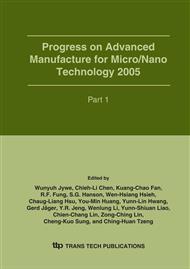p.199
p.205
p.211
p.217
p.223
p.229
p.235
p.241
p.247
A Study of Liquid Cooling Heat Sink Fabrication and Development in Notebook
Abstract:
Liquid cooling heat sink has excellent heat dissipation ability at the personal computer. It can also produce the similar effect at the notebook when the same heat sink is used. However, under the installing space is limited in notebook, the size and weight of heat sink must be limited too. Therefore a novel liquid cooling heat sink was fabricated herein to understand the heat dissipation efficiency in the notebook. Wire electrical discharge machining (WEDM) uses heat erosion effect to remove material and only produces little cutting force on the working surface. Therefore, WEDM has excellent ability to fabricate the straight micro fins (high 1000 μm, width 250 μm, fin gap 400 μm). The WEDM parameters were used to find the precision micro fins in this experiment. The precision micro fins were made when the cutting path offset was 185 μm in WEDM. WEDM would produce over cutting during long pulse duration and it caused oblique micro fins. The appropriate off time in cutting process would promote the WEDM efficiency. However, a liquid cooling heat sink with uniform micro fins and slits was obtained using WEDM.
Info:
Periodical:
Pages:
223-228
Citation:
Online since:
January 2006
Authors:
Price:
Сopyright:
© 2006 Trans Tech Publications Ltd. All Rights Reserved
Share:
Citation:


